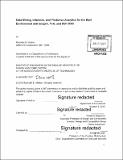Data mining, inference, and predictive analytics for the built environment with images, text, and WiFi data
Author(s)
Villalon, Rachelle B. (Rachelle Bentajado)
DownloadFull printable version (34.04Mb)
Other Contributors
Massachusetts Institute of Technology. Department of Architecture.
Advisor
Takehiko Nagakura.
Terms of use
Metadata
Show full item recordAbstract
What can campus WiFi data tell us about life at MIT? What can thousands of images tell us about the way people see and occupy buildings in real-time? What can we learn about the buildings that millions of people snap pictures of and text about over time? Crowdsourcing has triggered a dramatic shift in the traditional forms of producing content. The increasing number of people contributing to the Internet has created big data that has the potential to 1) enhance the traditional forms of spatial information that the design and engineering fields are typically accustomed to; 2) yield further insights about a place or building from discovering relationships between the datasets. In this research, I explore how the Architecture, Engineering, and Construction (AEC) industry can exploit crowdsourced and non-traditional datasets. I describe its possible roles for the following constituents: historian, designer/city administrator, and facilities manager - roles that engage with a building's information in the past, present, and future with different goals. As part of this research, I have developed a complete software pipeline for data mining, analyzing, and visualizing large volumes of crowdsourced unstructured content about MIT and other locations from images, campus WiFi access points, and text in batch/real-time using computer vision, machine learning, and statistical modeling techniques. The software pipeline is used for exploring meaningful statistical patterns from the processed data.
Description
Thesis: Ph. D. in Architecture Design and Computation, Massachusetts Institute of Technology, Department of Architecture, June 2017. Cataloged from PDF version of thesis. "February 2017." Includes bibliographical references (pages 190-194).
Date issued
2017Department
Massachusetts Institute of Technology. Department of ArchitecturePublisher
Massachusetts Institute of Technology
Keywords
Architecture.